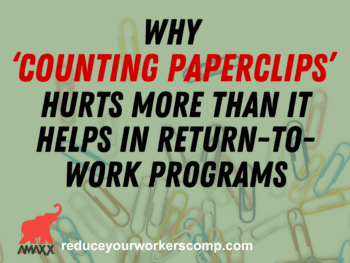The number one goal of any injury management policy is to return injured employees to work just as soon as they are medically able; ideally in their original state of health to their regular duty job. There is a difference between “medically necessary” and “medically unnecessary.”
Coordinating organized systems to reach the goal saves the company money. However, focus should also be on preventing and carefully managing injuries.
First, adopt a corporate-wide injury management transitional duty policy describing your company will implement transitional duty in the workplace. Include in the policy:
1. Length of transitional duty assignments.
2. Circumstances under which employees will perform transitional duty. (For example, TD is tied to continued employment.)
3. Types of transitional duty offered.
4. Circumstances under which employees will be returned to regular work.
5. When employees are eligible for ADA-compliant positions, upon their return to work after their medical or workers’ compensation leave.
Second, develop a job or task bank by identifying jobs and/or tasks accommodating the injuries of employees out of work for the transitional duty program. These can be videotaped and kept online where accessible to doctors and adjusters.
Third, hold weekly meetings with injured employees to monitor progress and document return-to-work obstacles. Discuss obstacles to return to work, or in transitional duty, determine if there are other obstacles such as medical bills not being paid timely. Show possible transitional duty jobs to the employee, ask what they can/cannot do on that job. Ask for medical restrictions on the Work Ability Form from the treating doctor, so you know what restrictions apply.
Fourth, hold an initial meeting with managment or include them in your monthly workers’ compensation meetings. At the meeting, cover these points:
1. Present the cost-savings benefits of returning employees to work in transitional duty to build and maintain management commitment.
2. Invite a member of management to join the injury management team.
3. Work with senior management and middle managers to implement a dollar-for-dollar charge-back system to the units where losses occur. (workersxzcompxzkit)
4. Design work-arounds to facilitate a timely return to work.
Author: Rebecca Shafer, J.D. Rebecca designs and develops workers’ compensation cost containment programs, and is the developer or Workers’ Comp Kit®, an on-line automated tool kit with an assessment, benchmarking and improvement plan. Rebecca can be contacted at: 860-553-6604 or email: RShafer@ReduceYourWorkersComp.com http://www.ReduceYourWorkersComp.com.
Submit articles to: Info@WorkersCompKit.com.
Try OUR FREE TOOLS:
WC Calculator: www.reduceyourworkerscomp.com/calculator.php
WC 101: www.ReduceYourWorkersComp.com/workers_comp.php
Follow Us On Twitter: www.twitter.com/WorkersCompKit
NEW ARTICLE: Return to Work in Unionized Companies
http://reduceyourworkerscomp.com/Return-to-Work-Programs-Unionized-Companies.php
Do not use this information without independent verification. All state laws vary. You should consult with your property casulaty insurance broker or agent about workers’ comp issues.
©2009 Amaxx Risk Solutions, Inc. All rights reserved under International Copyright Law. If you would like permission to reprint this material, contact Info@WorkersCompKit.com















